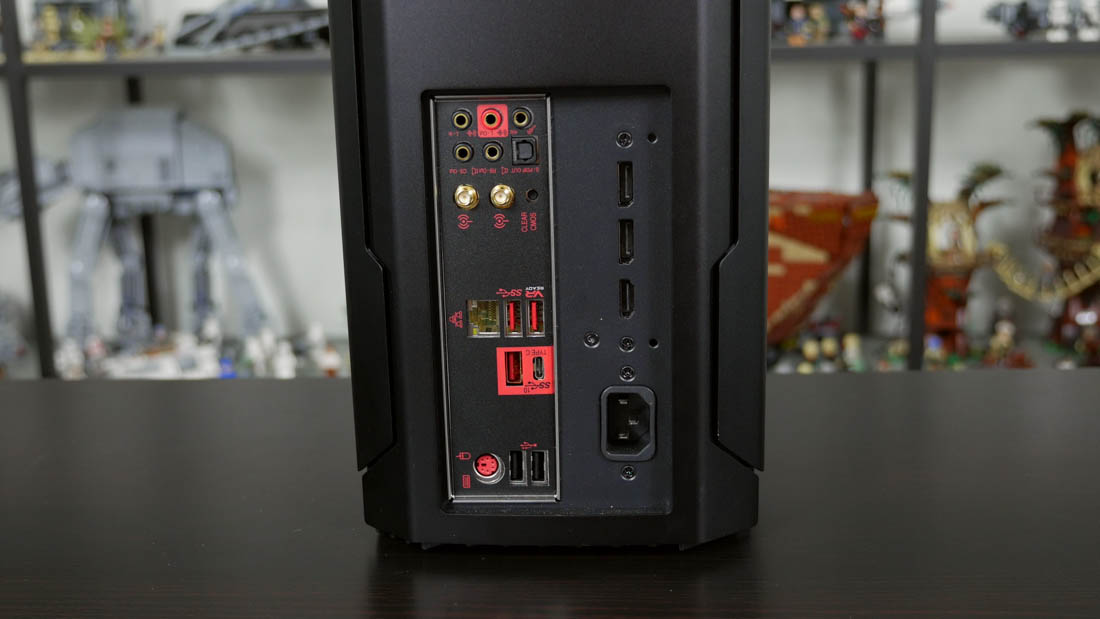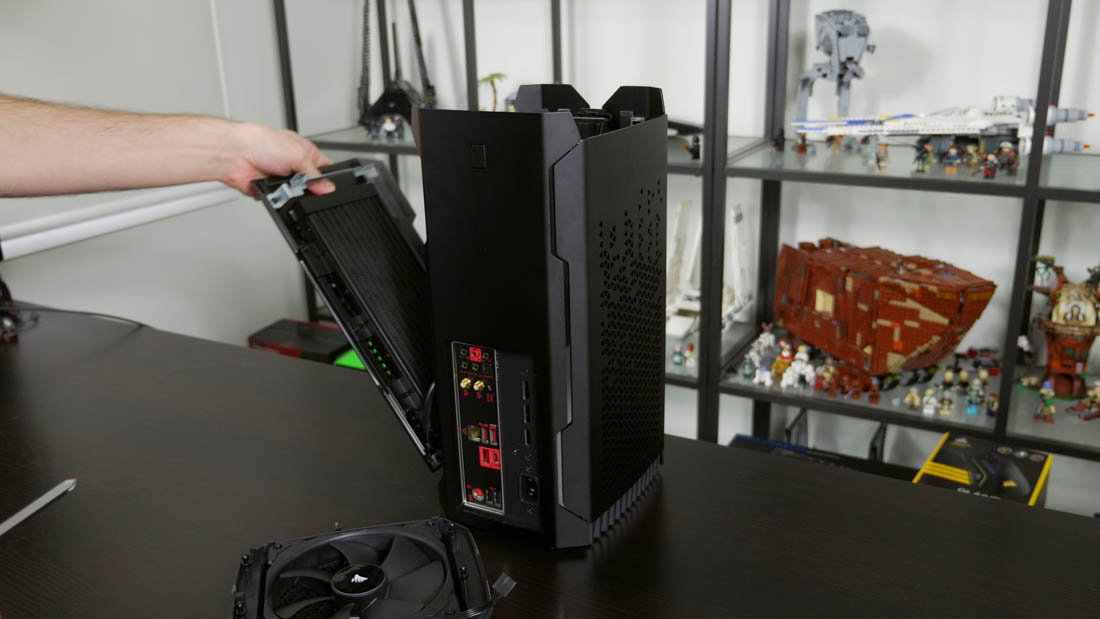The Corsair One is the ultimate compact gaming PC. I've looked at several pre-built small form factor systems over the years, and none are as well built or as powerful as this Corsair system. If you have a bunch of cash to spend, and you'd rather not build your own system or just want a beautifully-constructed compact tower, the One is genuinely the leading contender on the market.
Let's talk specs to kick this review off. The entry-level model - which costs $1,799.99 - packs a Core i7-7700 processor with GeForce GTX 1070 graphics, and a 240GB SSD with a 1TB spinning drive. That's a pretty good array of hardware for any gaming PC, let alone something that focuses on compactness.
Those who want the best in the business can purchase the Corsair One Pro, which is the same chassis but with more beastly hardware. The $2,199 model will get you a Core i7-7700K, GeForce GTX 1080, and a 480GB SSD. Buy through Corsair's web store, spend an extra $100, and you'll upgrade that SSD to a 960GB model. And for those that want the top tier model, $2,599 will see the GPU upgraded to a top-of-the-line GeForce GTX 1080 Ti.
All Corsair One units come with 16GB of DDR4 2400 MHz memory, a Z270 motherboard, an 80Plus Gold certified power supply, and Windows 10 Home installed out of the box. All units also feature a liquid-cooled CPU, while Corsair One Pro models get liquid cooled graphics as well.
Don't worry: we'll show you more of the liquid cooling setup later.
For those wondering, Corsair sent over a One Pro with the GTX 1080 and 960GB SSD to review. And boy is it a beast.
Before I talk about the performance, though, the Corsair One's beautiful design is worth exploring. Rather than opting for a more traditional flat-rectangle console shape, Corsair has gone with a trashcan chassis. Its footprint isn't a perfect square - the One is about 25mm deeper than it is wide - but it's slimmer and much, much shorter than a traditional gaming PC enclosure. Even though it's tall for a compact system, the One is the type of machine you can place anywhere due to its size. I reckon it looks great on a desk next to a large monitor.
If you want to compare it to modern game consoles, the Corsair One is approximately 13 liters in volume, whereas the PlayStation 4 Pro is 5 liters. But let's be honest, that isn't a fair comparison considering the Corsair One is significantly more powerful and an entirely different shape. The One does look larger than a typical game console to the eye, and it's not the smallest SFF gaming PC I've seen, though smaller systems tend to pack weaker GPUs (often the GTX 1060). You're trading off a bit of size for a lot more power with the Corsair One.
This system is one of the few compact gaming machines that actually looks good, and that's entirely down to the premium metal construction. Practically every side of the Corsair One is a piece of machined aluminum with a gorgeous matte-black bead-blasted finish. Its angular and curved design does have a few hints of 'gamer' style, though for this most part I think this system looks fantastic as a desktop or living room unit.
Some aspects of the One's design are particularly interesting, such as the thick fins along the top and bottom sides. While I don't think these fins are actually used for heat dissipation (that task is left to the internal radiators), their presence makes the One seem powerful. There's also a significant amount of perforation on the left and right sides, allowing air to be drawn through the aluminum panel, through the radiators, and out through the top of the system.
The Corsair One's front panel includes two aqua-blue LED strips that run top-to-bottom. Surprisingly for Corsair, these LED strips are not RGB, as according to Corsair, that wouldn't have provided the "desired aesthetic" for a cool, quiet system. The blue works well here and adds some interest to the otherwise black design.
I/O consists of a single USB 3.1 gen 1 port on the front, along with an HDMI port, for those that want to use the Corsair One for virtual reality. On the back you'll find a further three USB 3.1 gen 1 ports, two USB 2.0 ports for your keyboard and mouse, a USB 3.1 gen 2 Type-C port, Gigabit Ethernet, five 3.5mm audio jacks for surround analog audio plus optical S/PDIF, and two antenna connectors for its built in 802.11ac Wi-Fi solution.
Triple-display setups are possible thanks to two DisplayPort 1.4 connectors and a HDMI 2.0 port on the rear, all connected directly to the graphics card.
The inside of the Corsair One is arguably more impressive than the outside. The system is split into two zones to cool each of the major components efficiently. On the right is the MSI mini-ITX Z270 motherboard and SFX power supply, with full-height Corsair Vengeance RAM. The CPU is cooled by a closed-loop liquid cooler and 240mm slim radiator without a fan: the top Corsair ML140 140mm fan takes care of airflow in this system.
On the other side is a full-length GeForce GTX 1080, also attached to a closed-loop liquid cooler with a slim 240mm radiator. A blower fan provides some additional airflow for the GPU on this side, while extension cables send the display outputs from the graphics card directly to the rear of the system. A 2.5-inch SSD is neatly slotted into the front of the unit.
The great thing about this design is practically every aspect to the Corsair One is upgradeable without having to worry about proprietary components. The Core i7-7700K is socketed and can be easily replaced with any other LGA1151 CPU after you take off the liquid cooler. Upgrading the RAM is easy thanks to its two accessible DIMM slots. The SSD can be replaced as well; there's even a free SATA port if you can find space for another drive somewhere. Even the mini-ITX motherboard can be swapped out in the future if you want to do a platform upgrade, as the rear panel uses a standard I/O shield.
And upgradeability doesn't end there. You can swap out the graphics card as well, as Corsair has used an off-the-shelf desktop card in the One. Corsair tells me there's 11 inches of space for the graphics card, plus up to three standard slots for air coolers. Repurposing the liquid cooler for other GPUs may be tricky, but you can just chuck in a standard air cooler in the future without much fuss, aside from some added noise.
All of this upgradeability makes the Corsair One the perfect system for gamers who love to tinker and upgrade. You might have to shell out $1,800+ for the unit to begin with, but as new graphics cards and CPUs come out, the One will be able to accommodate them. You can't say that about most other pre-built SFF gaming machines.






